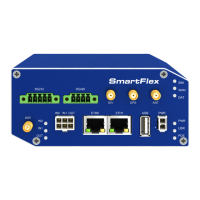SmartFlex
4.2 VRRP Configuration
VRRP via IPv6 (VRRPv3) is not supported.
Select the VRRP menu item to enter the VRRP configuration. VRRP protocol (Virtual
Router Redundancy Protocol) allows you to transfer packet routing from the main router to
a backup router in case the main router fails. (This can be used to provide a wireless cellular
backup to a primar y wired router in critical applications.) If the Enable VRRP is checked, you
may set the following parameters.
Item Description
Virtual Server IP Address This parameter sets the virtual server IP address. This ad-
dress must be the same for both the primary and backup
routers. Devices on the LAN will use this address as their
default gateway IP address.
Virtual Server ID This parameter distinguishes one vir tual router on the net-
work from another. The main and backup routers must use
the same value for this parameter.
Host Priority The active router with highest priority set by the parameter
Host Priority, is the main router. According to RFC 2338, the
main router should have the highest possible priority – 255.
The backup router(s) have a priority in the range 1 – 254
(default value is 100). A pr iority value of 0 is not allowed.
Table 21: VRRP configuration
You may set the Check connection flag in the second part of the window to enable au-
tomatic test messages for the cellular network. In some cases, the mobile WAN connection
could still be active but the router will not be able to send data over the cellular network. This
feature is used to verify that data can be sent over the PPP connection and supplements
the normal VRRP message handling. The currently active router (main/backup) will send test
messages to the defined Ping IP Address at periodic time intervals (Ping Interval) and wait for
a reply (Ping Timeout). If the router does not receive a response to the Ping command, it will
retry up to the number of times specified by the Ping Probes parameter. After that time, it will
switch itself to a backup router until the PPP connection is restored.
You may use the DNS server of the mobile carrier as the destination IP address for the test
messages (Pings).
The Enable traffic monitoring option can be used to reduce the number of messages that
are sent to test the PPP connection. When this parameter is set, the router will monitor the
interface for any packets different from a ping. If a response to the packet is received within the
timeout specified by the Ping Timeout parameter, then the router knows that the connection is
still active. If the router does not receive a response within the timeout period, it will attempt to
test the mobile WAN connection using standard Ping commands.
36

